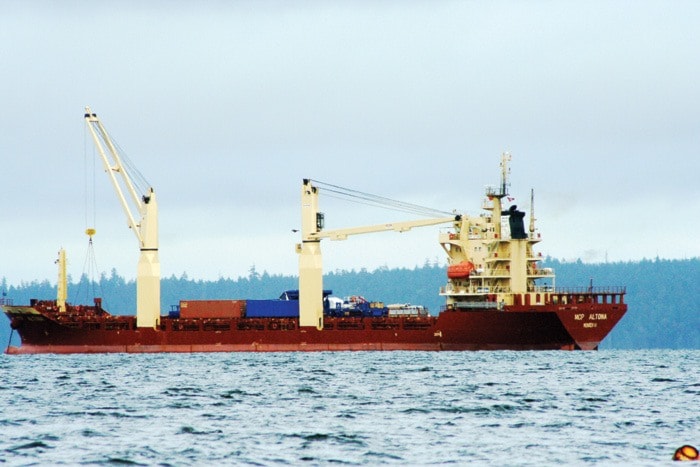View Larger Map
The water off Chemainus and Ladysmith played host to a large visitor that raised a few eyebrows last week.
The MCP Altona, loaded with uranium concentrate, had left Vancouver on Dec. 23 bound for China.
At sea, the Altona hit rough water and was forced to turn around when some of the uranium drums broke loose and spilled inside the ship.
Rob Gereghty, a spokesperson with Cameco (the company that produced and shipped the uranium) said at first it appeared only two barrels had spilled, but once an assessment team was able to enter the hull, they realized there was more.
“A number of the sea containers moved, so we are not able to get around and view the entire hold,” said Gereghty.
“I can tell you there’s more than two (drums spilled).”
Gereghty said the uranium concentrate was sealed in the cargo hold and presented no threat to people or the environment.
The ship left its moorage spot just feet from the shores of Chemainus on Jan. 20, bound for Vancouver for fuel and supplies before further action is taken.
In an update on Jan. 20, Gereghty said they were still unsure how much had spilled.
“We couldn’t get beyond the first part of the hold,” said Gereghty.
“There were a couple of sea containers that wouldn’t allow us to move around.
“We know it’s going to be a good size job.”
Gereghty said they were still in the process of creating their remediation plan and working with Transport Canada and Canadian Nuclear Safety Commission to determine how to best clean up the spill.
“The idea now is we are going to bring everything back to Key Lake (Saskatchewan, the site of the company’s mill),” said Gereghty.
A lot of the load will be cleaned up and left in drums and likely sent back to the original destination, said Gereghty. Transportation will be worked out by Transportation Canada and the CNSC.
On its arrival back in Canada, the Altona originally stopped in Victoria.
“The reason the vessel was moved from anchorage at Constance Bank, near Victoria, to Ladysmith was because of poor weather conditions,” said Jillian Glover with Transport Canada in an e-mail.
“Transport Canada agreed that the vessel should be shifted to a more sheltered anchorage, in order to conclude our initial assessments. The vessel was directed by a tug escort and a pilot was aboard when the vessel moved from Constance Bank to anchorage at Ladysmith.”
It’s arrival brought a mixed reaction, Kathy Wachs was able to see the ship from her bedroom window.
She said she never saw a reason to fret.
“If you believe the news reports, there’s nothing to be concerned about. I don’t see any reason for panicking at the moment,” said Wachs.
Wachs admits it makes her think about what kind of ships are coming through the Strait on a regular basis.
Wachs added she is not concerned the Altona anchoring near Chemainus will set a precedent for other ships to be brought to the area.
Dan Tyrrell, also a resident of Chemainus, said the ship raised some serious questions for him.
“My one question would be why would a boat, if it was no danger ... halfway to China turn around and come back to, particularly, Chemainus,” said Tyrrell when the ship was still moored near the Island.
Tyrrell said he was most concerned about the uranium concentrate hitting the wind.
Gereghty said the CNCS performed air quality tests around the ship.
“It was all clean,” he said. “Everything is sealed in.”
How to deal with any dust escaping would be part of the cleanup plan, he added.
“It’s a very meticulous job.”
Up to 35 drums can be held in each sea container and there are around 24 sea containers —roughly 840 drums on board.
That represents close to 350,000 kg of uranium concentrate, said Gereghty. The dollar amount, he said, depends on the contracts signed.
Gereghty said this is the first time in the company’s 20-year history that Cameco has had a problem with sea containers.
Gereghty said his company handles uranium on a daily basis and is confident they can clean it up without incident.
The biggest concern when handling uranium concentrate, said Gereghty, is not breathing it in when in close quarters.
Respirators are needed when people are with four to five metres of a drum, said Gereghty adding crews also wear protective gear.
“You can use a shovel and a broom to clean up a good portion of it.”
